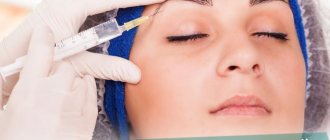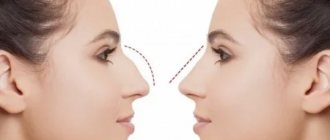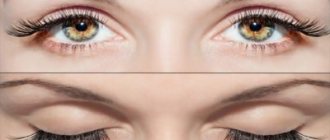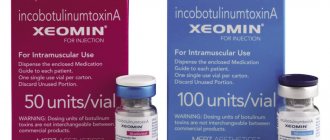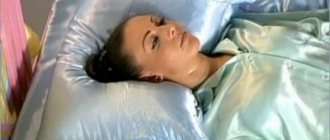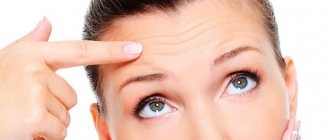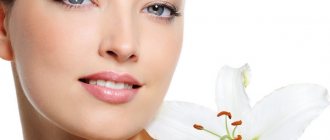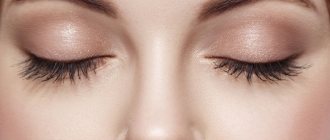In the modern world there are almost no women left who have not heard about Botox. One of the most popular ways to use it is by injection into the area around the eyes to smooth out crow's feet. This is where the skin is thinnest and most delicate, and expression lines appear first. Already at the age of 25-27, girls decide to take the dangerous path of so-called Botox rejuvenation, which sucks in like a quagmire and turns beautiful faces into ugly masks. This is partly to blame for the lack of awareness about the insidiousness of this procedure, which only seems effective. Cosmetologists don’t tell the whole truth about botulinum poison. We bridge knowledge gaps.
Age-related changes in facial skin
With age, facial skin begins to age and fade - it loses moisture, elasticity and turgor. The first changes can be observed as early as 25 years of age. First, dynamic wrinkles appear, which are also called facial wrinkles, because they form on facially active areas of the face (forehead, between the eyebrows, the area around the eyes). Over the years, they turn into deep, static creases and folds. In people with active facial expressions, the first wrinkles may appear even before the age of 25.
The mechanism of wrinkle formation lies in structural changes in the skin and muscular transformations. The skin loses strength and elasticity due to a reduction in the main components of youth: collagen, elastin, some fats, water. And the muscles spasm from overexertion, that is, they literally become shorter. And here is the result: the skin folded into an accordion.
Often, facial wrinkles appear earlier than others on the face near the outer corners of the eyes (“crow’s feet”) and on the lower eyelid. The skin in this area is delicate and quickly becomes covered with grooves and folds. To do this, simply smile and squint often.
It is believed that in 25% of cases the skin ages naturally, and in 75% the process is accelerated due to external factors: poor climate, poor diet, cosmetics, stress.
As a rule, by the age of 30, women are already looking for ways to get rid of wrinkles - the cult of youth, fashion and modern trends make us ashamed of our age and age-related changes. Because of this, in recent years even 20-year-old girls have been thinking about Botox. And this is just a disaster! And cosmetologists are unlikely to dissuade them and tell them the whole truth about this unnecessary and destructive procedure. And formally, contraindications to Botox injections exist only for persons under 18 years of age.
https://youtu.be/GrmNhG98Sb0
Effect of Botox on eyelids
The skin in the eye area is thin and delicate, so it is more susceptible to age-related changes than other areas of the face. In girls with active facial expressions, “crow’s feet” (facial wrinkles in the area of the outer corners of the eyes) appear at the age of 25 or earlier.
Signs of age on the face occur when blood circulation deteriorates, the structure of the dermis and muscle function change. The skin becomes less collagen, elastin, some fats, and water, which is why it loses strength and elasticity and begins to sag. And the muscles become overstrained from constant work. In the case of the eyelids, the orbicularis muscle, which is responsible for opening and closing the eyes, experiences a lot of stress.
How does this affect your appearance? Grooves and folds appear around the eyes. The upper eyelid droops (ptosis).
Combating these signs of aging is one of the most popular uses of Botox. How does it work?
Botox is a medical drug that contains the strongest poison botulinum toxin. It blocks the transmission of nerve impulses to the muscle, causing it to become paralyzed. The muscle stops contracting and stretching the dermis. The configuration of the muscular system and the vector of skin tension change. The drug is injected into the muscle through injection.
For what purposes is Botox done on the eyelids:
- smoothing out wrinkles,
- raising the upper eyelid and lowering the lower eyelid, opening the gaze,
- correction of eye opening asymmetry,
- raising eyebrows.
This article does not cover the medical uses of Botox used to treat strabismus, eye tics, and other uncontrollable muscle spasms and eye disorders.
Why is Botox done under the eyes?
Almost every woman, regardless of age, wants to remain beautiful and well-groomed. When she sees the first wrinkles in the mirror, she begins to panic, goes through options for rejuvenation and, in general, is ready to give everything she can just to somehow reverse the aging process.
And then cosmetologists appear with their “magic” procedure for instantly smoothing out wrinkles using Botox injections.
What age-related changes in the area around the eyes are proposed to be solved with Botox:
- wrinkles near the outer corners of the eyes (“crow’s feet”) and in the lower eyelid area,
- swelling and bags under the eyes,
- drooping (ptosis, drooping) of the upper eyelids,
- low location of eyebrow arches.
But what does the client get as a result, and at what cost?
Where is the procedure performed?
When you come across photos on the Internet before and after using Botox for eyebrows with horrifying results, the question arises - where to turn.
Procedures should be carried out correctly only in stationary clinics or aesthetic medicine salons. By talking directly with your doctor.
Individuals who administer Botox at home, who have received cosmetology training, and who practice outside of a hospital setting. Raising the brow arch and eliminating wrinkles without the participation of a qualified specialist is dangerous to health.
What is Botox
Botox is a drug based on botulinum toxin, a powerful poison of natural origin. It is a protein toxin produced by bacteria. Literally translated as "sausage poison", as it was discovered as a result of fatal food poisoning from spoiled sausage.
Man learned to produce botulinum poison artificially as a biological weapon, and then this development was put into use by doctors, followed by cosmetologists.
Botulinum toxin is a neurotoxin, that is, a poison that has a neuroparalytic effect. It blocks the production of acetylcholine, which ensures the transmission of nerve impulses to the muscles, causing them to be paralyzed. In medicine, this ability of botulinum toxin to affect muscles is used to correct various involuntary muscle spasms and movement disorders. Botox is especially common in ophthalmology and in the treatment of cerebral palsy.
What is important to know about the use of Botox in cosmetology? It does not eliminate the cause of aging, but only creates a temporary effect of smoothed and tightened skin for 2-5 months. This is not a means of rejuvenation! Botox deprives the muscle of its natural function of contracting, which is why the skin appears to smooth out. But the structure of the dermis does not change, the lost elasticity and strength do not return. The muscle is simply affected and then does not even fully recover.
Moreover, Botox accelerates the aging process of the skin. A paralyzed muscle will not completely return to its original state (although cosmetologists talk about its complete restoration). And, what’s even worse, when the muscle affected by botulinum poison stopped functioning, other neighboring muscles began to work for it. This led to their overstrain, loss of healthy tone and correct configuration of the muscular system. The result is new wrinkles on the face that were not there before the Botox injection.
Efficiency
The effect of Botox lasts, on average, 1-5 months. Then the result disappears. Manufacturers of some drugs containing botulinum toxin claim 9 months as the maximum duration of effect, but in practice this does not happen. In some cases, Botox does not produce any results.
Remember! Botox does not solve the problem of age-related changes in the eyelids, but only creates temporary appearance. You have to pay for a fleeting illusion with health and beauty. Botox disfigures the face, is toxic to the body and - attention! – accelerates the aging process. It is a poison that only causes harm.
We prove what cosmetologists are silent about or mention in passing as something incidental and insignificant.
Preparations containing botulinum toxin
Botox is commonly called any drug containing botulinum toxin. But in the strict sense of the word, Botox is the trade name of the first drug based on botulinum toxin. It was released by Allergan from the USA about 30 years ago. Having realized how profitable this business is, several more manufacturers from different countries began to produce analogues of Botox. All drugs contain the same active ingredient - botulinum toxin type A (BTA), produced at one time as a bacteriological weapon. The products differ in different concentrations of BTA, composition of excipients, particle size, duration of effect and a number of other parameters.
Botox
Botox is the first and most popular remedy among botulinum toxin-based drugs. This product from America was registered in Russia in 1994. In addition to BTA, Botox contains albumin and chloride, which should limit the diffusion of the poison, that is, its spread beyond the target. But this does not stop the toxin from spreading under the skin, which is why the face takes on an unhealthy shape. Botox is considered to contain a moderate dose of botulinum toxin and is of moderate potency. The initial effect appears on the 4-7th day and reaches its maximum after 2 weeks.
Dysport
Dysport is the main competitor of French-made Botox. Unlike Botox, Dysport has a 2.5-3 times lower dosage of BTA, but it is also about 2.5 times cheaper. Given the need to administer more units of Dysport, the cost of these drugs is comparable. If you need 10-20 units of Botox for crow's feet, 30-60 units for Dysport. Dysport acts stronger and longer than Botox, since its active particles are smaller and contain less albumin, which is designed to stabilize BTA molecules. All this indicates that Dysport has higher diffusion, that is, it spreads more actively beyond the target. The initial effect occurs faster than Botox: within 1-4 days from the date of the procedure.
Botulax
Botulax is a drug from South Korea, the country that produces the largest number of products competing with Botox. In terms of its composition, Botulax is almost a complete analogue of Botox, but cheaper. Accordingly, all their characteristics are almost identical, as are the consequences. It is noted that the duration of action of Botulax is somewhat shorter than Botox. There is also information that the use of the Korean drug is accompanied by more pronounced discomfort.
Relatox
Relatox is a Russian-made drug that entered the market in 2012. Cheaper than foreign drugs. It is positioned as an analogue of Botox, which begins to act faster and the effect of which lasts longer. But in many ways, this activity of Relatox is explained by the multiple smaller size of its particles: its molecular weight is 6 times lower than that of Botox. Therefore, it acts faster and seemingly more evenly on the target muscle, but at the same time it penetrates more actively into other muscles (strong diffusion), which is fraught with side effects. Also, unlike Botox, Dysport and Botulax, Relatox does not contain albumin, a stabilizing protein that inhibits the diffusion of poison and softens its effect. There are many reviews on the Internet about the poor quality of Relatox and the pain of its administration.
Xeomin
This is a German drug that contains botulinum toxin of the highest purity, therefore it is supposedly safer than its analogues, but also more expensive. The action comes a little faster than Botox and Dysport, but also ends earlier. Like the Russian Relatox, the molecular weight of Xeomin is very low, which indicates, on the one hand, a more uniform distribution of the drug, and on the other hand, a high ability to spread beyond the injection zone. But the diffusion of Xeomin is inhibited by the stabilizer albumin, which is even more abundant in the German drug than in Botox. It is believed that the effect of Xeomin is softer, without the “stony face” effect. It differs from its competitors in that it can also be stored at room temperature.
Lantox
A cheaper Chinese analogue of Botox, comparable in dosage and molecular weight, but does not contain albumin, which inhibits diffusion. Instead of albumin (human immunoglobulin), Lantox contains gelatin of animal origin, the task of which is the same: to impart stability to the botulinum toxin molecule and prevent excessive diffusion. The effect of Lantox is average in strength between Botox and Dysport.
How many units can you inject?
The dose of the drug used for Botox injections to lift eyebrows is determined according to:
- Features of the facial structure;
- Reasons for correction;
- Severity of muscle hyperfunction.
To achieve maximum effect, the procedure is divided into two parts. After the first injection of botulinum toxin, a break is taken. After ten days, the administration of the drugs is repeated.
Standard rate:
| Correction | units of solution |
| For slightly pronounced wrinkles, drooping eyebrows or eyelids | 2-5 |
| Folds on the bridge of the nose | from 15 to 25 |
| For complex forms of correction, the dosage increases | 10-30 |
In this case, the volume of neurotoxin in the injection increases, and not the amount of the injected solution.
Since the price of the procedure depends on the number of units of botulinum toxin administered, the approximate cost of botulinum therapy can be calculated. On average, a client will pay about 320-350 rubles for 1 unit.
How does the Botox procedure work under the eyes?
Typically, the Botox injection procedure follows the same scenario, regardless of the area of the face being treated. With injections into the area around the eyes, the sequence of actions is as follows:
- The cosmetologist asks the patient to smile, make a sad face and express other emotions to identify problem areas.
- Areas for injections are marked on the face. Four points are selected: two points near the outer corner of the eyes and one each near the tip of the eyebrow and in the area of the bone border.
- A special anesthesia is applied to the face.
- The drug is administered using thin needles.
- After the injections, the patient lies down for 10 minutes.
Contraindications
Despite the apparent ease of injections, there are some contraindications for which injections are undesirable:
- During pregnancy and breastfeeding;
- Skin diseases;
- Oncology;
- Epilepsy;
- Blood diseases;
- Individual intolerance to the drug.
Since the drug is administered intramuscularly, carefully study all possible contraindications and inform the specialist about allergic reactions to medications, medications taken during the procedure and previous diseases.
How long does it take for wrinkles to smooth out after Botox?
The visual effect of Botox injections appears 3-4 days after the procedure and reaches its maximum by the end of the second week. Some manufacturers promise visible results in just one day.
Waiting for change is accompanied by many troubles. As a rule, you have to put up with bruises and unevenness on your face for the first week. Your hands feel like the skin is falling inward. Often the face swells and additional folds appear that were not there before. You should not laugh or frown a lot, so as not to provoke wrinkles.
Often the effect after one procedure turns out to be such that it needs to be corrected. And this is a new trip to the cosmetologist and new portions of poison.
Doctors' recommendations after the procedure
In the first hours and two weeks after botulinum toxin injection, you should carefully follow the doctor’s instructions to eliminate the risk of consequences and promote better distribution of the neurotoxin:
- Do not rest in a lying position for at least four hours after the end of the procedure;
- Do facial gymnastics: slightly raise and lower your eyebrows;
- Do not massage;
- Do not resort to active facial expressions;
- Do not touch injection sites;
- Do not dry your hair with a hairdryer for seven days, avoid places with high air temperatures;
- Do not take antibiotics;
- Do not visit the solarium, bathhouse, sauna;
- Drink less fluid;
- Limit salty foods;
- Do not lift heavy objects.
Pros and cons of Botox under the eyes
If your goal is to get rid of wrinkles, then Botox is definitely not your option. Botulinum poison does not remove wrinkles. It gives a temporary effect due to muscle paralysis and does not in any way solve the problem of skin losing elasticity and strength. Botulinum toxin only works on facial wrinkles and does not affect deep ones.
And we haven’t yet talked in detail about the dangers of botulinum toxin and the mass of ugly side effects! The disadvantages of Botox injections under the eyes, like any other botulinum therapy procedure, can be listed endlessly. Judge for yourself. Botox under the eyes is:
- A blow to facial expressions and beauty.
The face loses facial expressions and becomes stony. At best, you won't be able to express your emotions. At worst, a paralyzed person will replace some emotions with others. It will seem to others that you are wincing in disgust, although you are smiling at that moment. Or you will seem angry when you are surprised by something. In addition, various side effects may occur on the face - a very common occurrence. This could be ptosis (drooping) of the upper eyelid, swelling, bruising, facial distortion, new wrinkles, and the like (read details in the next chapter). - Bad feeling.
After Botox, the injection areas often cause headaches. Fever, vomiting, dizziness and other health problems also occur. - Danger.
Since botulinum venom has diffusion, that is, it spreads beyond the injection zone, it can cause various complications in the eyes and not only. - Acceleration of aging.
Botox accelerates age-related changes. Paralyzed muscles do not fully recover, and the neighboring muscles that worked for them wear out faster. As a result, not only the wrinkles exposed to the poison return, but also new ones appear. - Botox addiction.
When, several months after Botox injections, the effect of the drug stops, the patient goes for a new portion of the poison. This happens over and over again. An addiction to botulinum toxin develops. The frequency of visits and dosages are increasing. Appearance is disfigured, health is undermined.
Are there any benefits to Botox under the eyes? In cosmetology - no. Only an illusion that turns into terrifying consequences. Even in medicine, where the use of Botox is justified for therapeutic purposes, this drug is feared. According to neurologists, the consequences that botulinum toxin can lead to have not yet been sufficiently studied.
How does the eyebrow lifter work?
What is Botox: a drug derived from botulinum bacteria. Neurotoxin type A is extracted from dead microorganisms. The substance is a poison; in small doses it is used to treat epilepsy, strokes, and relieve symptoms of cerebral palsy. In cosmetology, a pharmaceutical drug is administered to relax facial muscles that form unsightly folds. After the injection, a lifting effect occurs.
The procedure for raising eyebrows with Botox involves injecting the drug under the skin. The toxin affects nerve fibers, breaks impulse connections, and relaxes muscles. Spasms are relieved, the frowning effect disappears. It is recommended to inject Botox for eyebrows after the formation of a fold between the eyebrows, when the brow ridges are drooping, or when they are asymmetrically located.
To raise eyebrows, the doctor determines the required dose of medication. After botulinum toxin is activated, facial features change, muscles return to their original state. The woman is transformed, younger. The drug contains hyaluronic acid, it nourishes the dermis and straightens collagen fibers.
After lifting the eyebrows with Botox, many people get rid of the habit of frowning, the muscle fibers do not contract and remain relaxed. Involuntary facial expressions disappear. Changing the shape of the eyebrows changes the look, it becomes open, sparkles appear in the eyes.
It is a mistake to believe that a toxin has a detrimental effect on the body. The dose is negligibly small to talk about the systemic effect of injections.
Consequences and side effects of Botox under the eyes
But there are many known consequences of Botox that botulinum toxin treatment victims experience everywhere. We are especially interested in the side effects that occur after injections of botulinum venom into the area around the eyes. Let's name the main ones:
- Dry eyes and skin tightness.
Lasts several days in most patients. - Bruises, hematomas.
Capillaries are injured during injections in everyone, which is why bluish dots appear on the face, and often even ugly hematomas. The story may drag on for several weeks. - Pain when touching the eyes.
- Ptosis (drooping) of the upper eyelid.
Happens frequently. Occurs due to uneven distribution of botulinum toxin. The extreme form is the inability to open the eye. For the problem to disappear, it will take more than two months to completely remove the poison from the body. - Headache.
They may bother you for up to two weeks or more. - New wrinkles.
They arise due to the fact that neighboring muscles, trying to replace atrophied ones, worked in an increased mode and spasmed. - Severe swelling.
Due to unhealthy muscle tone, lymph flow is disrupted, resulting in swelling. It can be pronounced and not go away for a long time. - Facial asymmetry.
In the case of Botox in the area around the eyes, it usually appears in the form of asymmetrical eyebrows: one raised, the other lowered, and so on. - Eye pathologies.
Due to damage to non-target areas by the drug, eye complications may occur: paralysis of the eye muscles, anisocoria of the pupils (different sizes), mydriasis (pupil dilation), strabismus, blindness. - Allergy.
It occurs due to both botulinum toxin and auxiliary components. Possible anaphylactic shock.
Patient reviews
Those who have had Botox done to the eye area write that:
- no effect
- a frozen surprised look appears,
- injection sites become numb,
- eyelids become very swollen for several months,
- the eyes stop opening completely or partially,
- the face swells, the skin collapses when touched,
- the upper eyelid droops,
- new wrinkles appear.
Quote from a patient who had Botox done in the eye area:
“I can’t open my eyes and I have no idea when this horror will return to normal.”
The review was updated 7 months after the procedure:
“The drooping eye remained unchanged. After consultation with a neurologist, neuropathologist, after a total examination by an ophthalmologist, an MRI of the brain and facial nerve, and an appointment with a leading neurosurgeon, the unequivocal verdict is Botox’s FAULT!”
Experts' opinion
There are many forums on the Internet where cosmetologists can communicate with each other. Go to them and read what experts really think about Botox. Here are just a few statements:
Botulinum toxin is poison. A person is already exposed to the influence of harmful substances, and during the procedure he voluntarily agrees to the introduction of a toxin
(Alexey, cosmetologist with 15 years of experience, Voronezh)
The drug is addictive – physical and psychological. Under the influence of botulinum toxin, the muscles relax. After the drug wears off, the situation gets worse. From a psychological point of view, a person gets used to a smooth face, so even small wrinkles make him want to urgently inject botulinum toxin
(Nikita Yashin, young specialist in the field of cosmetology, Moscow).
There is a high risk of medical errors. There are very few experienced cosmetologists whose hands do not tremble. If the doctor injects into a point that is only a couple of millimeters away from the desired point, the result may be hopelessly spoiled
(Anton Laptev, cosmetologist in a private clinic, Samara).
Where and how to inject correctly?
Botox injections to lift the arch of the eyebrows are done in several places at once; the cosmetologist is able to adjust the shape of each of the eyebrow arches individually. The lifting scheme is drawn up based on the characteristics of the body, the presence of diseases, and medications taken. The type of injection is selected, and pharmacologists develop various formulations with toxin A.
You can raise your eyebrows not with one, but with several injections; their number depends on the lifting scheme and the urgency of the problem. 5 to 10 units of botulinum toxin are used.
If the pain threshold is low, local anesthesia is provided. Manipulation becomes comfortable. When the toxin is injected, the dermis is cooled to reduce pain and swelling.
The doctor decides where to inject Botox, taking into account the specific structure of the face. Usually injections are given:
- in the upper outer circular area of the eyes, create a smooth bend of the arc;
- the central part of the frontal muscle, removes frowning and pronounced hyperfunction of muscle fibers;
- between the eyebrow arches, after which they relax;
- under the brow muscle ridges along the entire length.
Before raising eyebrows with Botox, the skin is disinfected. If necessary, facial cleansing is carried out. Places to be corrected are indicated with a marker. On average, the correction takes 15 minutes, the woman does not experience much discomfort. Cooling treatments perfectly soothe the skin.
Indications for the procedure
Eyebrow asymmetry can be either congenital or acquired - for example, due to injury. Botox is suitable for correcting aesthetic imperfections in both cases. The amount of the drug for correcting aesthetic imperfections depends on the individual characteristics of the patient: the severity of the problem, skin density, and the area of the face where Botox is injected. For example, to correct fine wrinkles, 2-5 units are enough; to correct severe asymmetry, 10 to 30 units will be required.
Botox injections combine well with other cosmetic procedures. For example, hyaluronic acid preparations can be used to fill deep wrinkles. In this case, Botox helps smooth the skin, and hyaluronic acid fills the resulting folds and creases, smoothing the skin and replenishing the lack of moisture. This combination has a pronounced rejuvenating effect and can be used in any area of the face - the eyebrow fold, nasolacrimal groove, etc.
Application in ophthalmology
Ophthalmologists use Botox in their practice for:
- Muscular-tonic syndromes;
- Blepharospasm, when the patient cannot open his eyelids;
- Hemifacial spasm;
- Myofacial pain syndrome, accompanied by facial pain.
In addition, the toxin helps eliminate tics, nystagmus, pain, strabismus and migraines.
It is contraindicated to prescribe the drug in case of hypersensitivity to it, with myasthenia gravis, while taking antibacterial agents (aminoglycosides, tetracycline), during pregnancy and hemophilia.
How to prevent upper eyelid ptosis
No one can be immune from ptosis of the upper eyelid after a beauty injection. However, you can reduce this risk by following simple rules:
- You should only contact specialists who have been working with botulinum toxin for many years. This will minimize the number of errors associated with technique and dosage, and if a complication occurs, it can be quickly and safely eliminated.
- If minor neurological symptoms occur, the procedure should not be performed: due to overstrain, the muscles may react in an unpredictable way.
- Follow all recommendations for facial care after Botox injection: many of them are aimed specifically at preventing drooping eyelids.
What needs to be done when eyelid ptosis does appear after Botox? Contact another specialist with extensive experience, tell him in detail about the drooping eyelid and the procedure. Then he will use a different dosage of the drug and will be more attentive during the work process.
